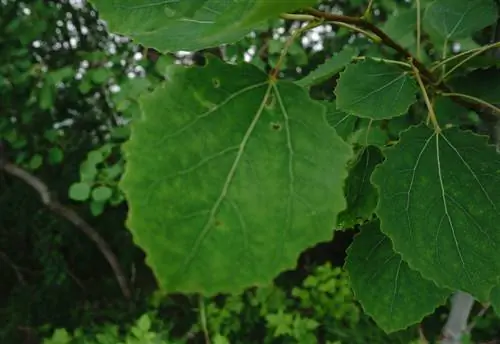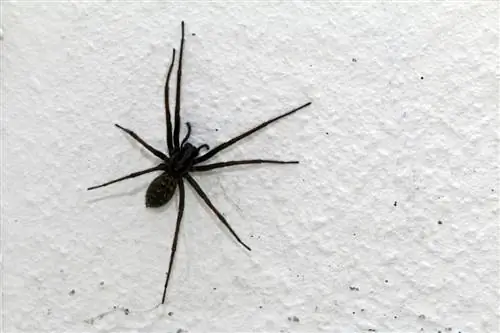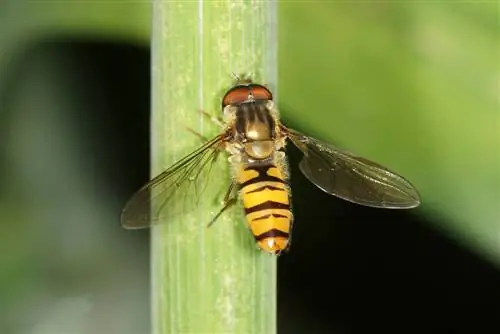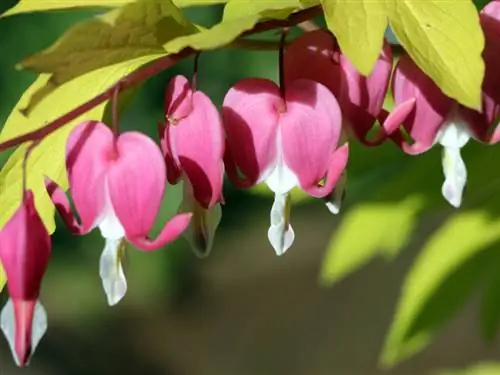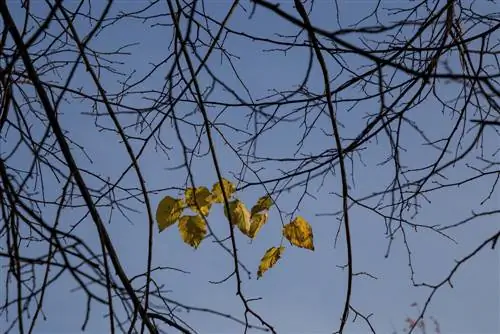- Author admin [email protected].
- Public 2023-12-16 16:46.
- Last modified 2025-01-23 11:21.
The leaves of the linden tree are probably one of the most characteristic features of the popular deciduous tree. On the one hand, its large heart shape has inspired poetic feelings in the past, but on the other hand it also has some practical advantages.

What do linden leaves look like?
Linde leaves are alternate, arranged in two rows and are characterized by a characteristic heart-shaped contour. The leaf size, shape, color and texture varies depending on the species. Some types of lime also have fine hairiness.
The typical heart shape of the linden leaves
The leaves of linden trees are alternate and two-lined, that is, arranged in a regular manner. Their generous bulges at the base of the stem are characteristic, almost legendary. In combination with the finely tapered tip of the leaf, the result is a clear heart shape that has given humanity countless emotional connotations. It is not for nothing that the linden tree has established itself as a symbol of love in many cultures and is the subject of numerous poetic works of art.
The connection between appearance and symbolism:
- regular leaf position
- heart-shaped outline
- therefore especially a love symbol
The characteristics depending on the species
In total there are around 20 to 40 types of linden trees, which of course always differ slightly from each other in their vegetative characteristics. In addition to quite different growth heights between 15 and 40 meters, the leaves also show their own characteristics, especially with regard to the following criteria:
- Size
- Shape
- color
- Texture
Size
Size is one of the most obvious criteria when distinguishing between species. Especially with the two most important species in our Central European latitudes, the summer and winter linden trees, size is the clearest distinguishing feature. The leaf of the summer linden tree reaches a length of around 12 cm, while the slightly rounder winter linden leaf is only around 6 cm long and 5 cm wide. The leaves of the American lime tree can even reach a length of around 20 cm. Thanks to their large, light leaves, linden trees provide extremely pleasant shade.
Shape
The leaf outline of the various types of linden trees is generally heart-shaped, although sometimes rounder and sometimes more elongated. The edge of the leaf is usually toothed, although there are different forms. The leaf of the Henry's linden tree, for example, shows very strong serrations, whereas the leaf of the summer and winter linden trees is rather fine. Some non-native species also have slightly varying leaf contours, such as the Mongolian linden tree with its distinct pointed lobes.
color
The colors vary only slightly, the leaves of summer or American linden are rather light, those of winter and especially silver or Crimean linden are darker. The silver linden tree also has a silvery coating on the underside of the leaves; the Crimean linden tree's leaves are shinier than those of the other varieties.
Texture
Some types of linden trees have fine hair on the leaf surfaces and also on the stems. This is the case, for example, with the summer and winter linden trees. The hair on the winter linden tree is brownish and on the summer linden tree it is whitish. In the winter linden tree, however, there is only hair on the veins on the underside of the leaf, whereas the leaf of the summer linden tree is completely covered with the fine fluff.
Indications of diseases
The leaves of the linden tree in particular can be indicators of pest infestation. This is particularly the case with the linden gall mite, which causes small red horns to form on the top of the leaves.

